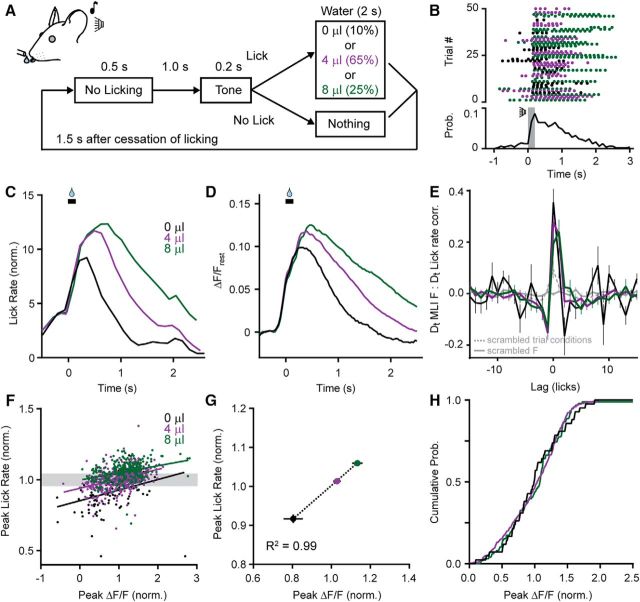Figure 3.
MLIs encode movement rate in their Ca2+ activity. A, Diagram of the cued licking task showing trial structure. A tone indicates the availability of water delivered pseudorandomly in three different aliquots. (Volumes are color coded.) B, Timing of licks for consecutive cued trials. Bottom, A plot of the average lick probability for all licking bouts during the session. The tone cue is indicated in gray. C, Average lick rate during cued trials sorted based on the volume of dispensed water. To correct for differences in lick bout duration, data were normalized across conditions to the lick probability at each time point and then aligned to the opening of the water valve (black bar). D, The average lick-induced Ca2+ response in MLIs varied depending on trial condition. E, Cross-correlation of the derivatives (Dt) of MLI activity and lick rate (solid lines colored based on water volume). When trial conditions were scrambled, there was a significant drop in the cross-correlation (dashed gray line). Also shown is a trace where fluorescence was scrambled (solid gray line). F, Data across all the trials were normalized to the respective mean (either peak ΔF/F or peak lick rate) for each session (7 sessions from 5 mice; average of 126 trials per session) to properly relate these distributions across different sessions, and plotted to compare the peaks of the MLI Ca2+ response and lick rate. There was a positive correlation for each trial condition, although in many trials, lick rates overlapped despite differences in the volume of dispensed water. G, The relationship between peak MLI Ca2+ activity and peak lick rate, plotted as averages for each condition across mice, was well fit with a linear regression. H, Cumulative probability from the subset of fluorescence data where lick rates were similar despite differences in the volume of dispensed water (data points are contained in the gray box in F, one SD in width surrounding the mean peak lick rate).

